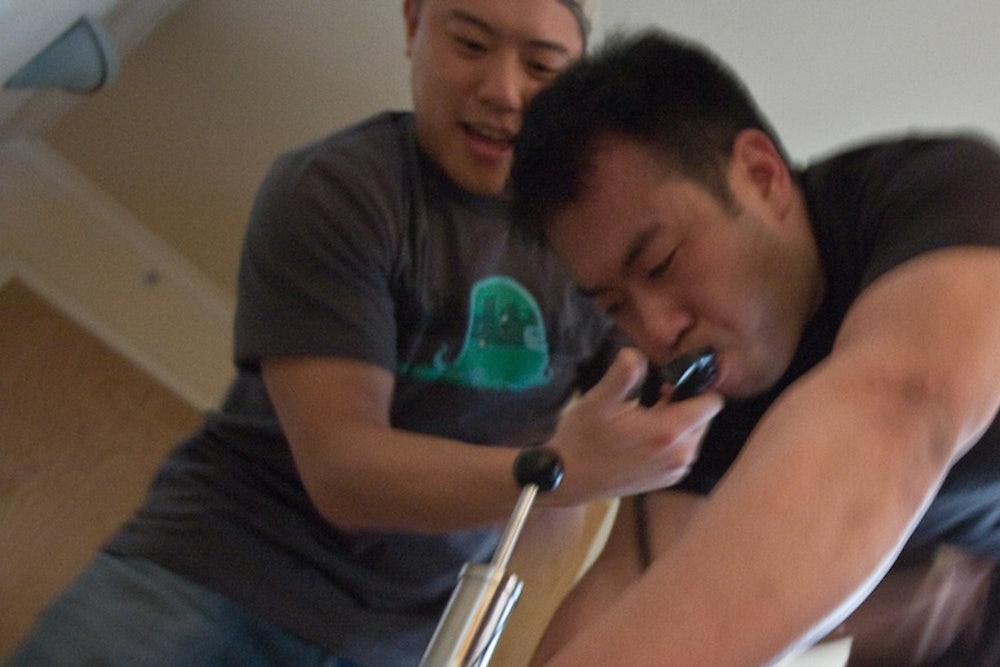On Sunday, The New York Times reported that "the binge-drinking rate among college students has hovered above 40 percent for two decades." The article described staggering resources that have been applied to this problem, and also how tailgating, bars near campuses with lax policies, and Greek life exacerbate it. But the Times ignored an institution that could make an enormous difference: the campus bar.
When I studied abroad at King’s College London in the fall of 2012, the wait to get into one of the campus bars—Guy’s Bar—was almost always over an hour. Guy’s was one of two bars run by the university, and until last year, the school also had a nightclub called Tutu’s. Both bars offer competitively discounted drink specials for students, snacks, and a chance to see and be seen. But these watering holes don’t just provide students with a cheap, convenient alternative to expensive London bars, they also afford the school enormous influence over how, when, and how much students at King’s drink.
Of course, most college students in the U.S. are not of legal drinking age. The U.K., where the drinking age is 18, doesn’t have this problem. But even given this hurdle (and given that we already allow very limited exceptions to drinking laws in certain circumstances), it’s worth considering the campus bar. Here’s how it could work:
1.
From the Times: “More than 1,800 students die every year of alcohol-related causes. An additional 600,000 are injured while drunk, and nearly 100,000 become victims of alcohol-influenced sexual assaults.”
If a bar were located on campus, DUIs and DUI-related student deaths could decrease dramatically. According to a fact sheet from the National Institute on Alcohol Abuse and Alcoholism, “each year an estimated 3,360,000 students between the ages of 18 and 24 drive under the influence of alcohol.” Meanwhile, according to census data compiled from 2009 to 2011, 12 percent of students nationally live in dormitories and group quarters, and 25 percent live off-campus. If students stayed on campus and close to home to drink, there wouldn’t be a reason to get in a car at the end of the night, let alone behind the wheel.
Drinks from bar tenders would be less susceptible to spiking and drugging, which could reduce incidents of sexual assault on campus. As Quartz pointed out yesterday, “According to [a federally funded] 2007 study, almost 60% of all completed sexual assaults on women occurred when the victim was incapacitated by drugs or alcohol.” A cup, bottle, or can handed directly from a bartender to a patron is harder for a third party to intercept and tamper with.
Keeping students on campus often keeps them closer to a hospital if medical care is needed. If a student is suffering from alcohol poisoning in the bedroom of a random house somewhere or in the bathroom of a club, it’s less likely that an authority figure could get involved, and bring that person to a hospital. The student might also be significantly farther from and less likely to receive emergency care than if the student stayed on campus, since many colleges and universities have affiliations with nearby hospitals.
2.
From the Times: “More than half of the bars surrounding campuses, they found, used discounts and other promotions to lure in students.”
Campus bars wouldn’t need to have the same revenue pressure as free-operating bars. As reported in the Times, some universities maintain budgets over $1 million to deal with the effects of binge drinking. Some of that money, instead, could be tapped to run campus bars. Additionally, many universities have large enough endowments to keep a bar open even if drinks are highly subsidized.
Bartenders employed by the university could be incentivized to cut off students who are too intoxicated. Rather than taking advantage of an inebriated student, bartenders could limit students to one drink an hour, or three drinks for the entire night, or use their own discretion to decide when someone has had enough.
3.
From the Times: “Drinking is so central to students’ expectations of college…”
Student groups could hold events at campus bars rather than off campus. If a cast wants to hold a wrap party, or a fraternity wants to throw down, at many schools, most likely they’d head to an off-campus house stocked with mixed drinks provided by the group itself. If there were a campus bar, student groups could rent the space than spending money to provide drinks and food for everyone. Bonus incentive: No one’s house gets trashed.
4.
From the Times: “Despite decades of research, hundreds of campus task forces and millions invested in bold experiments, college drinking in the United States remains as much of a problem as ever.”
Schools with campus bars could monitor students’ drinking habits and create more effective alcohol education programming. If students are buying alcohol directly from the school, the school will have more accurate information on what students prefer to drink, what time they drink, how much they drink, and who they drink with.
I turned 21 before I went abroad, and by the time I got back to campus that spring, most of my friends had caught up with me. We all but stopped going to house parties in lieu of going to bars, and I saw far less binge drinking in my last year and a half of school. It seemed that putting a price tag on drinking and removing its taboo contributed to changing people’s habits. So many programs and experiments have been tried with little success, maybe it’s time to give students what they want—and universities what they need.
